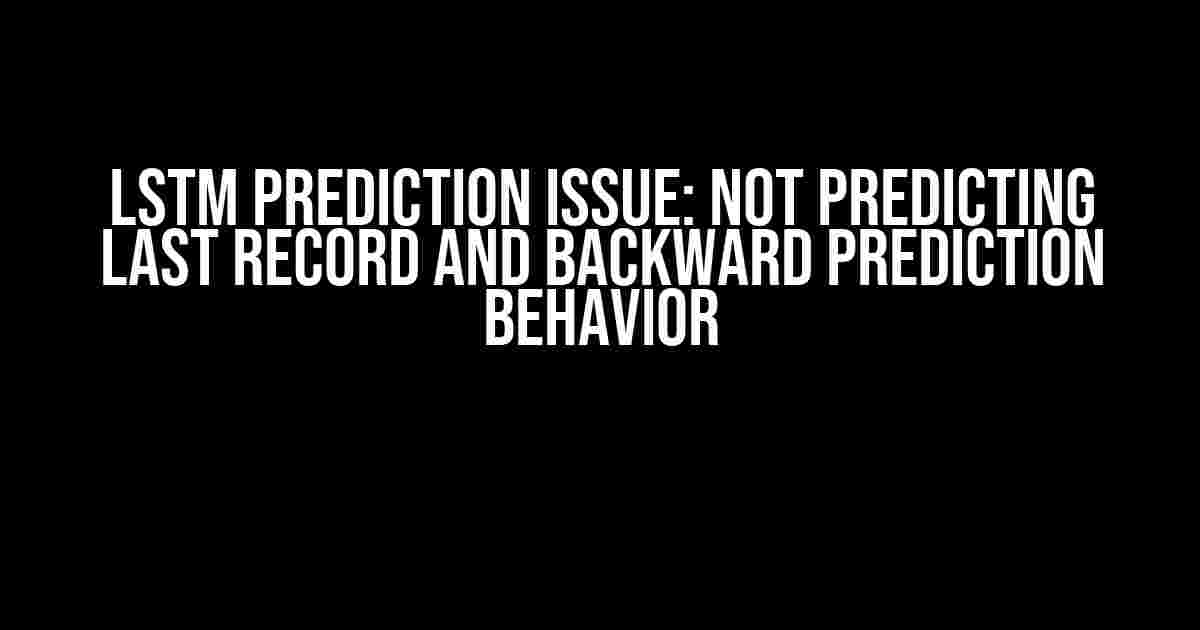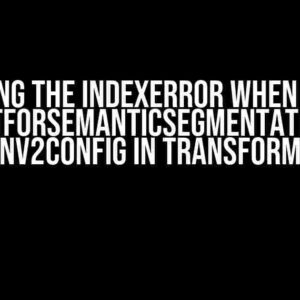Are you struggling with LSTM predictions that refuse to forecast the last record and instead exhibit backward prediction behavior? You’re not alone! This frustrating issue has plagued many a machine learning enthusiast, but fear not, dear reader, for today we’ll embark on a thrilling adventure to conquer this conundrum once and for all.
The Problem: LSTM Not Predicting Last Record
Let’s set the stage: you’ve crafted a meticulously tuned LSTM model, fed it a sumptuous feast of data, and waited with bated breath for the predictions. But, to your dismay, the model obstinately refuses to predict the last record in your dataset. What’s going on?
Theories and Suspects
Before we dive into the solutions, let’s examine some potential culprits behind this LSTM predicament:
- Padding issues: Are you using padding to handle sequences of varying lengths? Perhaps the padding is causing the model to ignore the last record.
- Batching: Are you using batching, and if so, is the last batch incomplete?
- Sequence lengths: Are your sequence lengths consistent across the dataset, or are some shorter or longer than others?
- Model architecture: Is your LSTM architecture suitable for the task at hand, or might it be too simple or complex?
- Data quality: Could there be issues with the quality or integrity of your data?
The Fix: Practical Solutions to LSTM Prediction Issues
Now that we’ve identified some potential suspects, let’s get to the good stuff – fixing the issue!
Solution 1: Adjust Padding and Batching
Re-examine your padding and batching strategy:
# Assuming you're using Keras
from keras.preprocessing.sequence import pad_sequences
# Pad sequences to a maximum length
max_length = 100
padded_data = pad_sequences(data, maxlen=max_length, padding='post')
# Use a consistent batch size
batch_size = 32
Tweaking padding and batching can help the model focus on the last record.
Solution 2: Check Sequence Lengths
Inspect your sequence lengths:
import matplotlib.pyplot as plt
# Plot sequence lengths to visualize the distribution
plt.hist([len(x) for x in data], bins=50)
plt.xlabel('Sequence Length')
plt.ylabel('Frequency')
plt.title('Sequence Length Distribution')
plt.show()
If you notice inconsistencies in sequence lengths, consider normalizing or trimming them to a consistent length.
Solution 3: Consider a Different Model Architecture
Experiment with different LSTM architectures or variations:
# Try a deeper or wider LSTM model
model = Sequential()
model.add(LSTM(64, return_sequences=True, input_shape=(max_length, 1)))
model.add(LSTM(32))
model.add(Dense(1))
# Or, attempt a GRU or bidirectional LSTM
model = Sequential()
model.add(GRU(64, return_sequences=True, input_shape=(max_length, 1)))
model.add(Dense(1))
model = Sequential()
model.add(Bidirectional(LSTM(64), input_shape=(max_length, 1)))
model.add(Dense(1))
This might help the model better capture the patterns in your data.
Solution 4: Data Quality Control
Scrutinize your data for errors or inconsistencies:
import pandas as pd
# Check for missing or null values
print(data.isnull().sum())
# Verify data types and ranges
print(data.describe())
# Look for outliers or anomalies
plt.boxplot(data)
plt.title('Data Distribution')
plt.show()
Clean and preprocess your data to ensure it’s reliable and consistent.
The Bonus Track: Backward Prediction Behavior
Now that we’ve tackled the LSTM prediction issue, let’s address the curious case of backward prediction behavior.
What’s Going On?
In some instances, your LSTM model might predict values in reverse chronological order. This can occur due to:
- Unnatural ordering: Your data might be sorted in a way that causes the model to learn a reversed pattern.
- Lack of temporal dependencies: If your data lacks strong temporal dependencies, the model might not understand the direction of time.
The Fix: Addressing Backward Prediction Behavior
To counteract backward prediction behavior, try:
Solution 1: Reverse Data Order
# Reverse the order of your data
reversed_data = data[::-1]
This can help the model learn the correct temporal dependencies.
Solution 2: Add a Temporal Component
# Incorporate a temporal component, such as a timestamp
data_with_timestamp = pd.concat([data, pd.Series(range(len(data)))], axis=1)
This adds an explicit temporal dimension to your data, guiding the model’s understanding of time.
Solution 3: Regularization Techniques
# Apply regularization techniques, such as dropout or L1/L2 regularization
model.add(LSTM(64, return_sequences=True, input_shape=(max_length, 1), recurrent_dropout=0.2))
Regularization can help prevent the model from learning unwanted patterns or overfitting to the data.
Conclusion
Congratulations! You’ve made it through this epic journey to conquer the LSTM prediction issue and backward prediction behavior. By implementing these practical solutions and theoretical insights, you’ll be well on your way to taming the mighty LSTM beast.
Remember, when facing this issue, don’t panic! Take a step back, reassess your approach, and try the solutions outlined above. With persistence and patience, you’ll overcome this hurdle and unlock the full potential of your LSTM model.
| Solution | Description |
|---|---|
| Adjust Padding and Batching | Re-examine padding and batching strategies to ensure consistent sequence lengths and batch sizes. |
| Check Sequence Lengths | Inspect sequence lengths to identify inconsistencies and consider normalizing or trimming them. |
| Consider a Different Model Architecture | Experiment with alternative LSTM architectures, such as deeper or wider models, GRU, or bidirectional LSTM. |
| Data Quality Control | Verify data quality, checking for missing values, outliers, and inconsistencies, and preprocess data accordingly. |
| Reverse Data Order | Reverse the order of your data to help the model learn correct temporal dependencies. |
| Add a Temporal Component | Incorporate a temporal component, such as a timestamp, to guide the model’s understanding of time. |
| Regularization Techniques | Apply regularization techniques, such as dropout or L1/L2 regularization, to prevent overfitting and promote generalization. |
Now, go forth and conquer those LSTM prediction issues!
Frequently Asked Question
Get the inside scoop on resolving the pesky LSTM prediction issue that’s got you stumped!
Why is my LSTM model not predicting the last record?
This issue often arises due to the way the model is configured or the data is preprocessed. One potential cause is that the model is not receiving the correct sequence length, resulting in it ignoring the last record. Check your data preprocessing and sequence length configuration to ensure they align with your model’s expectations.
What’s causing my LSTM model to exhibit backward prediction behavior?
This unusual behavior might be due to the model’s architecture or the data itself. It’s possible that the model is overfitting or has an incorrect implementation of the LSTM layer. Try regularizing the model, adjusting the hyperparameters, or experimenting with different architectures to resolve the issue. Additionally, inspect your data for any anomalies or inconsistencies that could be influencing the model’s behavior.
How can I ensure my LSTM model is correctly predicting future values?
To ensure accurate future predictions, focus on creating a robust model that generalizes well. Implement techniques like walk-forward optimization, data augmentation, and cross-validation to evaluate your model’s performance. Additionally, consider using a rolling window approach to test the model’s ability to predict future values.
What role does sequence length play in LSTM prediction issues?
Sequence length is a critical parameter in LSTM models, as it directly affects the model’s ability to capture dependencies. A sequence length that’s too short might lead to the model ignoring the last record, while a sequence length that’s too long can result in the model overfitting. Experiment with different sequence lengths to find the optimal value for your specific problem.
Are there any specific LSTM architectures that can help alleviate prediction issues?
Yes, certain architectures can help mitigate LSTM prediction issues. For example, the Encoder-Decoder architecture is well-suited for sequence-to-sequence tasks and can help resolve issues related to sequence length. Additionally, BiLSTM and Stacked LSTM architectures can provide more accurate predictions by capturing both forward and backward dependencies.


